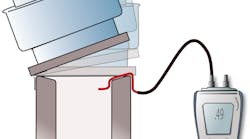Return grilles are a frequently overlooked HVAC system accessory. Ignoring these devices and their function leads to problems such as noise and dirt bypassing the filter. Let's look at four traits you should never ignore to reduce return grille-related problems.
One: Stamped Return Grille Sizing
It's common to find a lot of duct systems issues on the return air side. Just as the average return duct system is undersized, so are the grilles attached to it.
You can have a perfectly sized duct system that acts like it's restricted if the return grilles are undersized. An undersized grille acts the same way because room air can't make it into the return duct system. Think of it like trying to run a marathon, breathing through only a straw. The air just can't get into your lungs.
Just as the average return duct system is undersized, so are the grilles attached to it.
By the way, keeping the airspeed moving through a return grille (face velocity) between 300 fpm (feet per minute) to 500 fpm reduces grille noise. It's easy to hear a grille that exceeds this velocity range. Just listen for a whistle or low-pitched hum when the HVAC system is running.
When you size a return grille, choose one that can handle the total airflow of the area it serves. Let's say you have three supply registers, each feeding 150 cfm (cubic feet per minute) of air into a room. The return grille for that space should handle 450 cfm (150 x 3 = 450 cfm)
Two: Return Air Filter Grille Sizing
You should size return air filter grilles for a maximum airspeed of 400 fpm. When choosing a filter grille, look at the manufacturer's engineering data. First, locate theIf engineering data is unavailable, you can multiply the filter grille area by square inches, twice cfm per square inch.
If engineering data is unavailable, you can multiply the filter grille area by square inches, twice cfm per square inch. The result gives you an approximate airflow the filter grille can handle. In most cases, this simple rule should keep airspeed at the filter grille below 400 fpm.
For example, let's say you have a single 14 x 20 filter grille, and you want to know if it's large enough for a two-ton air handler. First, figure out the filter grille area (14 x 20 = 280 square inches). Next, multiply the filter grille area by two cfm per square inch (280 sq. in. x 2 cfm = 560 cfm).
A two-ton air handler needs between 700 and 800 cfm to operate correctly, so a 14 x 20 filter grille is too small. You would need a single 20 X 20 filter grille for a two-ton unit rated to move 800 cfm (400 sq. in. x 2 cfm = 800 cfm). How often do you see a 20 X 20 return filter grille on a two-ton unit? Answer: Not enough.
Three: Transfer Grille Selection
Central return filter grille installations frequently use transfer grilles to relieve room pressure when an interior door is closed. It's important to select low-pressure drop return grilles for the best performance.
Don't install just any return grille that covers the rough opening.
Do your homework. Don't install just any return grille that covers the rough opening. Remember, natural pressure differences cause air to travel back to the central return when the door is closed.
Stamped face grilles might not produce the desired results because of their increased resistance. Instead, use a low-pressure drop commercial-grade grille to get better performance in these installations.
Four: Return Grille Location
Contrary to popular belief, return grille location doesn't have much influence on room air movement. This statement goes against what most in our industry believe. I should know. I'm someone who used to swear return location influenced air movement.
It's important to understand that return grilles rarely affect supply register air patterns, regardless of how much air moves through the return grille. Instead, the impact occurs much closer to the return grille face.
Even though returns don't have much influence over air movement, it's a good idea to place them in a location that isn't in the supply airstream.
Even though returns don't have much influence over air movement, it's a good idea to place them in a location that isn't in the supply airstream. This prevents "short-circuiting" and allows supply air and room air to mix evenly before entering the return grille.
There can also be safety implications if a return's location influences combustion appliance operation in the same space. When a return is too close to the equipment, it could cause back-drafting.
Why Not Offer Return Grille Upgrades?
Additional return duct capacity is a common upgrade to duct systems during equipment replacement. Why not upgrade the return grilles on your next replacement to performance-grade grilles, as you find on commercial systems? Return air filter grilles also provide an opportunity to increase filter surface area and lower static pressures.
Pay attention to the details when you select return air grilles and provide a better product that exceeds your customers' expectations.
David Richardson serves the HVAC industry as Director of Training for National Comfort Institute, Inc. (NCI). NCI specializes in training that focuses on improving, measuring, and verifying HVAC and Building Performance.
If you're an HVAC contractor or technician interested in learning more about improving your duct systems, contact David at ncilink.com/ContactMe or call 800-633-7058. NCI's website www.nationalcomfortinstitute.com is full of free technical articles and downloads to help you improve your professionalism and strengthen your company.












